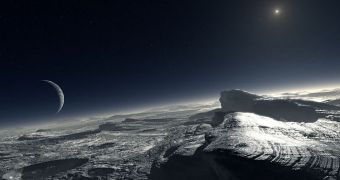About five years ago, astronomers demoted Pluto from a planet to a dwarf planet, but the move – while still controversial – did not decrease researchers' interest in the small celestial body. When the NASA New Horizons space probe reaches it in 205, the spacecraft will change our view of the rocky world.
As a general rule in space exploration, scientists have noticed that every time they propose a world holds no surprises, this usually turns out not to be the case. In other words, they tend to encounter interesting things, structures or phenomena precisely on inconspicuous world.
This is also what they expect to find on Pluto. New Horizons launched for the dwarf planet on January 19, 2006, and is expected to arrive at its destination in mid-2015. At that time, it will not enter orbit around the dwarf planet, but rather continue its journey into the Kuiper Belt.
The flyby it will carry of Pluto and its moons will however provide astronomers with a wealth of data that cannot be discerned from available observations. The object is simply too far away and too small for telescopes to observe in detail.
The NASA probe is heading towards the dwarf planet at a speed of 36,000 miles per hour (nearly 58,000 kilometers per hour). The American space agency says that this is the fastest spacecraft ever built, and also the first probe dedicated specifically to this body.
“We've never had a reconnaissance of a dwarf planet such as Pluto before, and every time we've been to a new type of planet, we find nature is much richer than we expected,” explains Alan Stern.
The expert – who is the principal investigator of the mission – holds an appointment as a research scientist with the Boulder, Colorado-based Southwest Research Institute (SwRI), Space reports.
“We should expect Pluto to reveal how complex dwarf planet systems can be. We may even find rings around Pluto,” he adds. This discovery was recently made by a team of astronomers using a computer model. Only New Horizons will be able to confirm or infirm this theory.
One of the most exciting things about the new mission, Stern says, is precisely its unpredictability. There is no telling what the NASA probe will discover in the system. What experts do know is that the object has four moons, and maybe a dust ring around it.
Pluto is not the largest object in the Kuiper Belt. That title goes to Eris, which orbits the Sun even further away than its counterpart. Haumea, Makemake and Ceres make up the three other established dwarf planets.
According to the International Astronomical Union (IAU), there may be as much as 200 objects that can be classified as dwarf planets roaming the solar system. A group of 40 are already being considered for upgrading to official dwarf planet status.
“Before space exploration, the thought was that smaller worlds would be less complex than larger ones. But one of the surprises that came with the exploration of planets is that smaller worlds are often extremely complex, sometimes more than bigger worlds,” Stern concludes.

 14 DAY TRIAL //
14 DAY TRIAL //